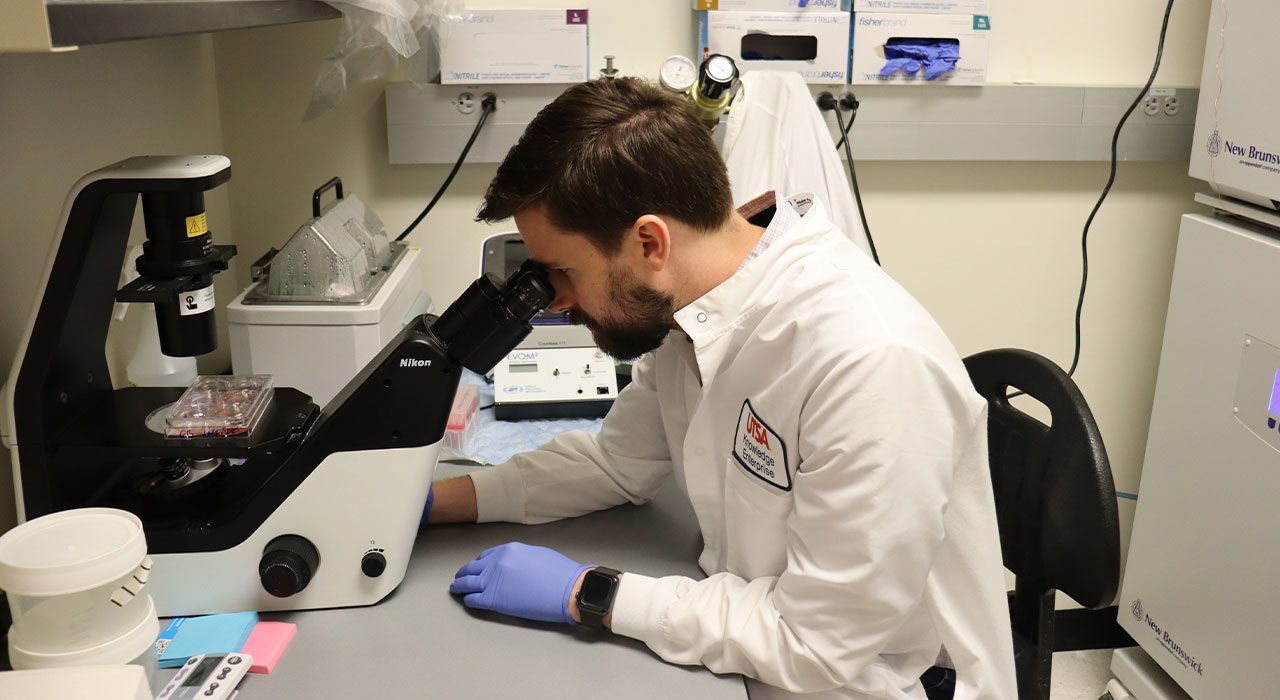UTSA researchers in the Max and Minnie Tomerlin Voelcker CIDD Preclinical Pharmacology Core for Accelerated Drug Discovery were recently awarded a competitive grant that will allow access to a unique piece of equipment to expedite the discovery of novel, life-saving drugs.
For six months, UTSA researchers will have access to the QPatch-II 48, an advanced instrument designed by Sophion Bioscience that uses an automated patch clamp system to analyze cell samples.
A patch clamp system measures ion flow across cell membranes, a key process in nerve impulses, muscle contractions and drug interactions. By automating ion channel research, the QPatch-II 48 will enable UTSA scientists to rapidly test new drug candidates, develop new ion-channel targeted therapies and identify toxicity associated with ion channel inhibition. This work will accelerate the discovery of treatments for diseases such as epilepsy and Parkinson’s disease.
“We now have a more comprehensive suite of services in-house to enable researchers to prioritize their best drug candidates for further development.” — Nicholas Clanton
The equipment will be on loan to UTSA from Sophion Bioscience, a leading global life science firm based in Denmark that was formed in 2000 by specialists seeking to improve biomedicine. The UTSA Pharmacology Core was selected for the loan due to its expertise in preclinical drug development and its contributions to critical research areas such as cancer, non-opioid pain management, and neurodegenerative diseases.
“This new technology will allow us to conduct targeted ion channel screening in an automated, high throughput format, addressing a crucial gap in the San Antonio-Austin biomedical research community,” said Nicholas Clanton, assistant director of the preclinical pharmacology core.
The QPatch-II 48 will be installed in UTSA’s Preclinical Pharmacology Core this summer for a six-month trial period in a first-of-its-kind equipment lease from Sophion. Once installed, the core will be one of a very select number of research facilities in Texas with access to an automated patch clamp system.
The core’s research is strengthened through collaborations with Jenny Hsieh, the Semmes Foundation Distinguished Chair in Cell Biology and the director of the Brain Health Consortium, and Chris Navara, director of the Stem Cell Core and professor of research. The Hsieh Lab plans to use the patch clamp system to explore treatments for children diagnosed with epilepsy while Navara’s research group will use the system to investigate new therapeutic targets for Parkinson’s disease.
Additionally, Stanton McHardy, director of the Center for Innovative Drug Discovery and professor of chemistry, will leverage the technology for cardiac safety screening in early drug discovery.
“Cardiac safety screening was a missing link in our preclinical development pipeline,” added Clanton. “We now have a more comprehensive suite of services in-house to enable researchers to prioritize their best drug candidates for further development.”
The UTSA Pharmacology Core plans to leverage this six-month trial period to gather data and secure additional funding for a permanent acquisition of the QPatch-II system, solidifying the university’s role as a regional leader in biomedical research.
“The importance of early-stage safety assessment in drug development cannot be overstated. With the increasing costs of drug development, the elimination of problematic candidates early in a program is more important than ever,” said Clanton. “The acquisition of a Sophion QPatch-II automated patch clamp system will allow us to provide efficient and cost-effective screening to identify cardiac safety risks in drug candidates and accelerate the overall drug development process.”
This award comes at a time when UTSA is preparing to merge with UT Health San Antonio, and the addition of this new technology in the Pharmacology Core has already sparked multiple new collaborations across our campuses. Last year, the UT System announced the merger, which will establish a world-class university for San Antonio and a global hub of academic and research excellence.
The UTSA Pharmacology Core was established in 2021 as part of the university’s Center for Innovative Drug Discovery (CIDD) to reduce costs and accelerate drug development. UTSA researchers utilize the Preclinical Pharmacology Core’s cutting-edge preclinical pharmacology and translational drug development capabilities to launch new therapies in a broad range of areas, including cancer, cardiovascular disease, neurodegeneration, chronic pain and infectious diseases.



